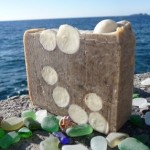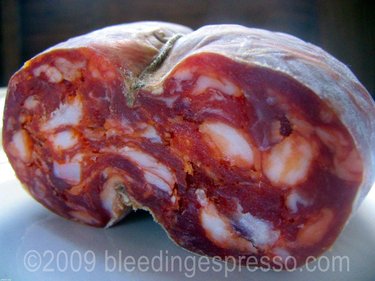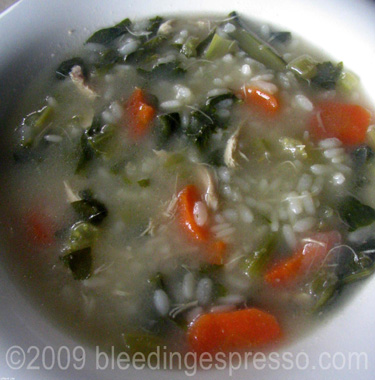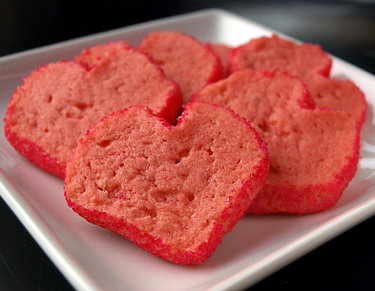Archive for the ‘food’ Category
What’s Cooking Wednesday: Calabrian Scrambled Eggs
 This week’s What’s Cooking Wednesday is an old *and* new family favorite. My grandmother used to make it all the time, and now P and I make it quite often as well.
This week’s What’s Cooking Wednesday is an old *and* new family favorite. My grandmother used to make it all the time, and now P and I make it quite often as well.
Calabrian Scrambled Eggs are definitely one of my all-time fast and filling dishes–and it can also be great for using up leftovers. This is a fab dish for singletons as well as you can easily make just enough for one person.
Now you may be asking yourself: Self, what exactly makes these scrambled eggs Calabrian?
It’s the supressata*, silly:
You can, of course, substitute with any kind of meat you like from sausage to ham to mortadella (bologna), and it will be just as tasty. Only a bit less Calabrian is all.
And in case you don’t already, I hope you think of scrambled eggs in the same way as you would an omelet…anything goes. That is, if you like it and think it will go nicely with eggs, have at it!
Calabrian Scrambled Eggs
Uova strapazzate alla Calabrese
(serves two)
- Two tablespoons olive oil
- One small onion, sliced
- About a handful of cubed supressata (probably about 100 g)
- 4 eggs
- Splash of milk
- Two pinches of salt
- One slice of meltable cheese (Sottilette in Italy)
1. Heat oil over medium in a nonstick pan and add onion and supressata. Let them fry for a few minutes until the onions soften and the meat starts to release its juices.
2. In the meantime, break eggs into a bowl, add milk and salt, and beat together well.
3. Pour egg mixture into pan and add cheese in small pieces.
4. Move eggs around as they cook to get that patented scrambled look; they’re ready when they’ve set and are no longer runny.
5. Serve hot, and if you’re like us, with crusty Italian bread and a nice tomato salad. Yum!
Buon appetito!
*Alternatively known as sopressata, soppressata, suppressata, and “soupies” back in the Anthracite Coal Region.
What’s Cooking Wednesday: Homemade Chicken and Rice Soup
 Are you someone who would never think of making your own chicken stock because it sounds way too Martha Stewarty, i.e., complicated?
Are you someone who would never think of making your own chicken stock because it sounds way too Martha Stewarty, i.e., complicated?
Well this week’s What’s Cooking Wednesday is for you.
Making your own chicken stock is easy peasy, plus you’ll feel like a star chef when you’re done…and then you’ll wonder why it took you so long to brave the task of making chicken stock. Seriously. *So* easy and delicious!
In the recipe below, I’ve listed that you need a chicken, but you actually don’t. All you really need are the remains of a chicken with just a little bit of meat left on it, skins, whatever you’d normally discard from a chicken. If you’ve picked clean a rotisserie chicken, use that! It makes fabulous, already well-seasonsed stock.
Aside from the chicken, for great soup, I recommend *always* putting in onion and celery (whole or chopped, up to you), and then, well, whatever else you like and/or have available. This particular go-around, I added carrots and chard because that’s what I had in my fridge, but you can add corn, peas, spinach, escarole, whatever you like.
Now yes, making homemade soup does take a bit of time, but it’s not like you have to stand over the pot the entire time. Especially if the weather is still chilly where you are, may I recommend:
Homemade Chicken and Rice Soup
(about 6 bowls of soup)
- 1 small chicken
- Cold water to cover the chicken
- 1/2 lb. chard, chopped coarsely
- 2 stalks celery, chopped or left whole
- 3 onions, left whole
- 2 carrots, sliced
- Salt to taste
- Ground black pepper to taste
- 1/4 cup rice per person
- Grated parmesan cheese (optional)
1. Put chicken in a large stock pot and cover it with cold water. Cook on medium to high heat for about an hour and a half, periodically skimming off foam that surfaces.
2. Cook chard in salted, boiling water until it’s soft.
3. Once the chicken is cooked, remove it from the water and let cool, and remove any remaining foam.
4. Add the celery, onions, carrots, salt, and pepper to the broth, and let cook for another half hour or until you start to see that the onions are getting mushy. Take out the biggest chunks, but if you like, take some of the mushiest and chop them very finely to throw back in.
5. In the meantime, clean off the chicken and put the meat back into pot, discarding bones and skin.
6. Add chard to broth.
7. Cook rice either in broth or separately.
8. Serve with grated cheese if you like (I do).
Buon appetito!
Now, for broth beginners, are you going to try this or what? And for you experts, do you have any chicken stock tips to share?
Going Green: 21 Ways to Reuse Coffee Grounds
 It’s the first Friday of the month, which means it’s time again to talk about Going Green. Last month we discussed green cell phones and cell phone recycling, and today we’re moving on to another way to recycle and reuse.
It’s the first Friday of the month, which means it’s time again to talk about Going Green. Last month we discussed green cell phones and cell phone recycling, and today we’re moving on to another way to recycle and reuse.
And we’re talking coffee. Coffee grounds, actually.
As you well know, I drink coffee, and apparently so do many of you; coffee is the most consumed beverage worldwide with 400 million cups downed each year. Now that creates a lot of used coffee grounds!
Did you know there are lots of ways you can reuse coffee grounds instead of just throwing them in the garbage? Here’s a short list:
21 Ways to Reuse Coffee Grounds (and Coffee)
In the garden:
1. Organic fertilizer: Sprinkle them in the soil of plants that love acidic soils, especially rosebushes (my roses *love* coffee grounds!), rhododendrons, camellias, evergreens, carrots, and radishes.
2. Organic pest and ant repellent: Sprinkle areas where ants, slugs, and snails hang out and destroy your garden.
3. Organic cat repellent: Yes, I love cats, but if you want to keep them out of your plants and garden, coffee grounds will do the trick.
4. Mushroom growing soil: Inoculated mushroom plugs nestled into moist coffee grounds can mean a great mushroom crop for you. Put grounds in a glass container and press a mushroom plug into them, repeating with more grounds and mushroom plugs until you run out of room. If you see mold, just remove it.
5. Bait worm life support: Add coffee grounds to soil to help keep bait worms alive longer.
In the house:
 6. Closet deodorizer: Old pantyhose plus coffee grounds equals a sachet to keep your closet free of odors.
6. Closet deodorizer: Old pantyhose plus coffee grounds equals a sachet to keep your closet free of odors.
7. Refrigerator and freezer deodorizer: Place ground in a small cup and in the fridge or freezer much as you would baking soda.
8. Pin cushion filler: If you still use pin cushions (like I do), dried coffee grounds are a great filler for the cushions.
9. Abrasive cleaner: For stubborn grease and stains on pots and pans, coffee grounds really get in there and do the job.
10. Dust deflector: We’re talking about the fireplace here; sprinkle coffee grounds on ashes before you start collecting them to minimize the dust. I *love* this tip and use it often.
11. Furniture scratch toucher upper: Use a Q-tip and coffee grounds to fill in scratches on wooden furniture–remember the coffee will stain the wood a bit, so don’t use it on something that won’t match.
12. Drain cleaner: Be careful with this one as you don’t want to clog your drain with coffee grounds! *But* to counter odors coming from your drain, you can pour about a half a cup of coffee grains down the drain followed by boiling hot water to get the grounds through. No more smells!
13. Meat tenderizer: This is one for leftover coffee as opposed to coffee grounds; soak steaks in coffee to tenderize and for an interesting added flavor.
14. Chocolate cake flavorer: Used grounds and fresh grounds both give a little kick to chocolate baked goods, including brownies.
In your beauty routine:
 15. Hand soap: Rub grounds on your hands to get rid of stubborn odors like onion and garlic. In fact, the soap I use in my kitchen is made with used coffee grounds–Caffè Vaniglia soap from Saponissimo.
15. Hand soap: Rub grounds on your hands to get rid of stubborn odors like onion and garlic. In fact, the soap I use in my kitchen is made with used coffee grounds–Caffè Vaniglia soap from Saponissimo.
16. Face mask: An egg white mixed with 1/4 cup grounds makes a great exfoliating face mask.
17. Hair rinse: After washing your hair, rub in coffee grounds for shine, softness, and even a bit of color for those of you who are dark-haired; remember coffee grounds act as a dye, so if you have light hair, unless you want highlights, this one isn’t for you.
18. Cellulite rub: Mix one tablespoon of olive oil with 1/4 cup moist, warm coffee grounds and spread on cellulite hot spots. Wrap tightly with plastic wrap, leave on for a few minutes, and then remove wrap and shower as normal. For best results, do a couple times a week. If anyone tries this, you *must* let me know how it turns out.
For fun:
19. Dye: Use a mix of coffee grounds and water to dye clothing, paper, or even Easter eggs.
20. Tattoo base: Make homemade temporary tattoos using coffee grounds and henna.
And finally, on your doggie:
21. Dog flea dip: I haven’t had the nerve to try this one yet, but next bath time, my dogs are getting some coffee grounds rubbed into them after the shampoo and rinse routine.
By the by, even if you don’t drink coffee, you can ask your local coffee shops and other places that serve coffee for their grounds, and start reusing them. The environment will thank you!
Do you currently reuse coffee grounds? How?
If you don’t reuse coffee grounds, which of these suggestions might you try?
Buon weekend & Happy Birthday Dad!
Love Thursday: Kitty Noses and Cookies
OK, just one kitty nose, but look how cute it is with the heart on it!
This is a photo of Abbie, whose human is Maggie of Dog Hill Kitchen, a *fabulous* blog with recipes like Chocolate Espresso Pudding Cupcakes with Caramel Milk Foam and Strawberry Jello Heart Cookies:
Can’t you feel the love?
Then go tell Maggie at Dog Hill Kitchen you
*heart* her photos and recipes!
Happy Love Thursday everyone!
Recipe: 30 Minute Brownies from Scratch
These brownies really do take 30 minutes *maximum* to make from start to finish, so that’s what I’m emphasizing; prepared mixes take just about the same amount of time and clean up will be about the same . . . so why not make them yourself from ingredients you know and love?
Read on...


















